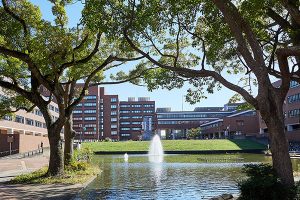Participation in Spring School
Applied Science and Engineering Spring School 2023
~One-Day Hands-on Classroom for High School Students~.
The Applied Science and Engineering Spring School will be held on Wednesday, March 29, 2023. Using the experimental equipment of the School of Applied Science and Engineering, students will receive direct instruction from faculty members and university students who are conducting cutting-edge research. Why don’t you deepen your interest in science and technology by experiencing experiments on familiar phenomena?
We are pleased to announce that the Spring School has ended successfully.
The Spring School has ended successfully. Thank you to all the high school students who participated.
Click here to download the poster
See below for a brief description of the day’s flow and experimental content
| 開催日 | 2023年3月29日(水) |
| 参加費 | 無料 |
| 集合場所 | 筑波大学第3エリアA棟 3A402室 |
| 当日のプログラム | 12:30-13:00 受付 13:00 開校式、学類長挨拶 13:15 模擬講義 14:30~ 体験実験 (約2時間) |
| 模擬講義 | Materials that Absorb and Emit Light” Lecturer: Hiroshi Yamagishi |
| 体験実験 | (1) The World of Zero Electrical Resistance – Experience Superconductivity Electrical resistance is a measure of the ease with which electricity flows through a material, and although metals such as the copper used in 10-yen coins flow electricity well, they do not have zero electrical resistance. However, there are materials called superconductors that have zero electrical resistance. On this day, we will introduce the general properties of superconductors and conduct a demonstration experiment in which participants can directly touch a superconductor. Let’s make hydrogen – electrolysis of water An experiment will be conducted to create hydrogen using electrolysis of water, one of the carbon neutral technologies. Participants will experience what kind of changes occur by using not only platinum electrodes but also various types of electrodes. (3) Looking at familiar objects and phenomena through the eyes of science We will look at familiar phenomena such as light, color, sound, temperature, electricity, ice, metals, painting, mathematics, electromagnetic waves, and food with the eyes of science. Even if you don’t like science, it’s okay. Students who love wonder are welcome! Let’s make glowing semiconductor nanoparticles! Students will create semiconductor nanoparticles that glow in different colors. Based on the results of spectroscopic experiments, we will think about the reasons for the change in the color of the light. 5) Electron microscopes open up the microscopic world around us Recent electron microscopes have evolved to the point where they can observe water-containing samples and biological samples as they are. In this hands-on learning experience, we will collect and observe cedar pollen and lactic acid bacteria, which are living organisms that exist in our daily lives. Enjoy the various forms of the microscopic world. ⑥ Plasma for the future ~ Experience plasma around you and at the cutting edge! ~(7) Plasma for the Future – Experience plasma around you and at the cutting edge! We are planning to visit the fusion plasma experimental apparatus and measure the emission spectrum of plasma discharge lamps. ⑦ Observation of graphite atomic sheet Let’s observe the atomic layers and atomic arrangement of graphite using a scanning tunneling microscope, which has atomic-level resolution. Let’s make a metal that looks like glass! Atoms are arranged regularly in metals (crystals). However, in “glass” used for cups and windows, atoms are not arranged in a regular manner, but rather are randomly arranged and solidified (amorphous). In this hands-on experiment, we will actually make an alloy in which the atoms are not arranged in a regular pattern and compare its properties with those of ordinary metals and glass. (9) Let’s investigate the mechanism of semiconductor light-emitting devices by spectroscopy using a diffraction grating. The same white color emits light by different mechanisms? What is the difference between a light emitting diode and a laser diode? By using a diffraction grating with a periodic structure, light can be divided into its components (spectroscopy). Let’s investigate the differences in light emission mechanisms between light-emitting diodes (LEDs) and incandescent lamps, which emit the same white light. Also, let’s try spectroscopy of LEDs and laser diodes (LDs), which emit the same red light, and have fun experimenting by changing the magnitude and temperature of the current flowing through the LEDs and LDs to see what changes. (10) The World of Semiconductor Manufacturing Process ~Experience the photolithography process necessary for fine patterning. (11) Let’s take pictures of crystals with X-rays Students will take pictures of silicon (Si) and salt (NaCl) crystals using X-rays. You will experience that beautiful patterns reflecting the arrangement of atoms can be observed, which is completely different from those observed in radiographs. (You will take one of the above experimental subjects. Which theme will be announced on the day of the course) |
| 参加対象 | 高校生 |
| 申込方法 | 必要事項を明記の上、以下の申込フォームにてお申込みください。 https://forms.office.com/r/eJZteuJkpG |
| 締め切り | 3月22日(水) 先着50名 |
| 問合せ | 筑波大学応用理工学類 事務室(電話:029-853-4963) |
| アクセス | つくば駅より関鉄バス6番のりば「筑波大学循環」行に乗車し、「第3エリア前」で下車してください。バスは約10分おきに「筑波大学循環(右回り)」(所要時間約12分)、「筑波大学循環(左回り)」(所要時間約20分)が出ています。 |


